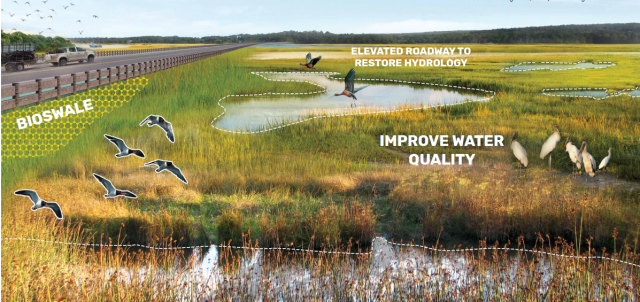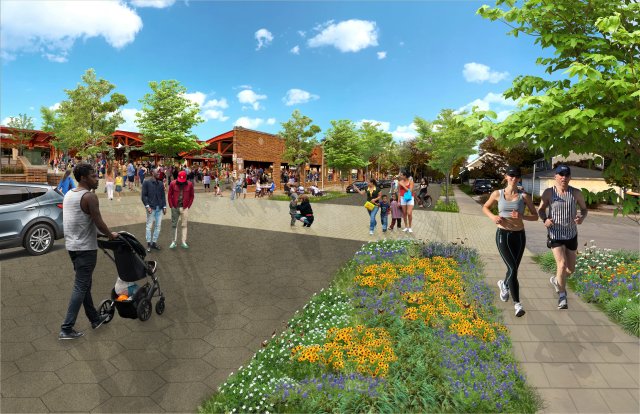Building Blocks for Regional Resilience
In 2020 and 2021, EPA adapted the Building Blocks for Sustainable Communities program to focus on regional resilience and disaster planning. Using the Regional Resilience Toolkit, EPA helped multiple jurisdictions come together to identify shared natural disaster risks and develop a common action plan for the region.
On this page:
On other pages:
- Regional Resilience Toolkit: This resource promotes an inclusive, coordinated approach to disaster planning and collaborative regional-scale actions.
- Building Blocks for Sustainable Communities: This technical assistance program works with local communities across the United States, including tribes and territories, to develop smart growth solutions and strategies in ways that benefit human health and the environment.
- Community Change Equitable Resilience Technical Assistance: Offered in conjunction with the Community Change Grant Notice of Funding Opportunity, this technical assistance provided free design and project development assistance, community engagement, and partnership development workshops that support climate resilience and environmental justice activities in disaster-prone areas.
Background
EPA's Office of Community Revitalization works with communities to support inclusive and locally-led planning processes to strengthen local capacity, facilities partnerships, and creates a path forward to achieve community-identified goals. The Building Blocks for Regional Resilience, adapted from its Building Blocks for Sustainable Communities program, supported regional efforts to identify shared natural disaster risks and develop a common action plan.
Through a series of planning calls, a self-assessment, and an on-site workshop with community partners, the Regional Resilience program supported communities and their partners set resilience goals, prioritize assets to protect, and develop resilience strategies and funding plans. These efforts helped regions gain a deeper understanding of the disaster risks and identify specific steps for plan implementation. The program also used the Regional Resilience Toolkit and brought its framework and approach down to the project site level by offering targeted design assistance.
2021 Partner Communities
In 2021, EPA worked with four regions across the country to deliver technical and design assistance.
Saint Helena Island, South Carolina

The Gullah/Geechee community of Saint Helena Island and Beaufort County requested assistance on developing a network of green infrastructure projects to buffer storm surge and mitigate sea level rise impacts while also protecting local food production, historic sites, and cultural traditions. During this project, EPA worked with community members to map assets throughout the island for green infrastructure projects and to develop an action plan and funding sources. The project highlighted the connections between sites and set clear resilience goals for each location. The community worked with the county and state to ensure culturally appropriate adaptation solutions were reflected in plans and policies.
Visit the interactive StoryMap highlighting some of the green infrastructure designs and next steps to help Saint Helena Island and the region build more sustainable, resilient communities.
Cape Ann, Massachusetts
The Cape Ann region consists of four communities in Massachusetts: Gloucester, Rockport, Essex, and Manchester-by-the-Sea. The region requested assistance with community outreach to address threats from sea level rise, winter nor’easters and hurricanes, droughts, flooding, and excess heat. The region's goal was to develop an action plan identifying regional priority projects and funding sources, building on the ongoing TownGreen2025 climate work and studies, and focusing on how to fully engage the public and a wide variety of stakeholder organizations in shaping priorities and implementation strategies.
Nolensville, Tennessee
Nolensville and the Mill Creek Watershed Association prepared for expected explosive population growth by implementing a state-of-the-art plan that recognized the links between watershed planning, stormwater management, and flood plain protection. The plan identified green corridors that would highlight the town’s beauty, support outdoor recreation and wildfire habitat, and establish a resilient community. As a result of the assistance, partners were prepared to be able to act on updating local plans and codes with strategic growth solutions and implement specific green infrastructure projects.
Orange County, Florida
Orange County includes thirteen inland cities in Florida. The county wanted to integrate various resilience plans, which include hazard mitigation plans, climate vulnerability plans, comprehensive plans, and economic development plans. Many economically vulnerable people in the coastal areas nearby are at risk of losing their homes due to environmental factors such as flooding, hurricanes, and sea level rise. The action plan sought to create a streamlined county-wide implementation and funding strategy for absorbing climate refugees and increasing community resilience to climate threats. The action plan was also intended to assist in positioning the community for new grant opportunities to fund mitigation of climate impacts.
2020 Partner Communities
In 2020, EPA worked with four regions across the country. All projects sought to address economic resilience, in addition to disaster resilience, as part of their planning process.
West Allis, Wisconsin

The Milwaukee Metropolitan Sewerage District used this project to narrow its focus on specific recommendations from its 2019 Resilience Plan, which was developed in partnership with 55 regional stakeholders, including elected officials, private-sector representatives, and nonprofits. MMSD used this project to select priority actions from the plan’s 20 recommended actions that address critical infrastructure and develop a pilot project in West Allis with a detailed implementation and funding plan. MMSD intended to use lessons from this project and scale up the effort in partnership with other municipalities in the region. This project was funded in partnership with EPA’s Office of Water.
Visit the interactive StoryMap highlighting some of the green infrastructure designs and next steps to help the West Allis community become more walkable and resilient.
Land of Sky Regional Council, North Carolina
The Land of Sky Regional Council (LOSRC), covering a five-county region in western North Carolina, used this assistance to build on regional vulnerability assessments by conducting broader community outreach and determining clear steps toward regionwide action to reduce risks from flooding, wildfire, and landslides. LOSRC included these actions as updates to the long-range transportation plan and regional land use plan in 2020. In addition to the regional-scale work, LOSRC supported local and county-level resilience actions. LOSRC planned to do additional analysis to characterize the specific risks from flooding, wildfire, and landslides to underrepresented communities, including urban and rural low-income and minority (as well as aging) residents, who can be more vulnerable to disasters for a variety of reasons.
Southern Minnesota
Minnesota Homeland Security & Emergency Management (HSEM) and Interagency Climate Adaptation Team (ICAT) used this technical assistance to help communities think comprehensively about resilience actions that have co-benefits, so they can reduce flood risk as well as address other chronic stressors that disproportionately affect rural, agricultural areas. The project focused on the southern region of the state because of its history of flooding, which affects physical infrastructure such as roads and rural electric utilities and causes farms to lose crops and livestock, and because projections suggest more frequent and intense rainfall will continue to disproportionately impact this agricultural region. The technical assistance helped local officials and policy-makers better understand why the farming community is particularly vulnerable to floods, success stories from other farming communities, specific natural hazard mitigation actions and climate adaptation strategies, and key funding sources and partners to implement priority actions. HSEM and ICAT used this assistance to figure out a replicable model of resilience technical assistance that can be applied in other rural parts of the state.
Portland Metropolitan Region, Oregon
EPA worked with Oregon Metro and the Regional Disaster Preparedness Organization to convene cities and counties in the Portland metropolitan region to identify local and regional actions to mitigate impacts to public health from extreme heat and wildfire smoke. A three-part workshop series took place in January 2021.
The technical assistance resulted in a report, Extreme Heat and Wildfire Smoke: Reducing Risks to Public Health in the Portland Region (April 2021), which outlines findings from the three-part workshop series. The report provides guidance for planners looking to incorporate wildfire smoke and extreme heat hazards into their local hazard mitigation plans. It includes:
- A screening tool to help planners use data about who lives in their communities and determine what risks these hazards pose - both to the community at large and to more vulnerable people or neighborhoods in the community;
- A list of potential actions that local governments and regional partners can take to help protect these vulnerable people and places from extreme heat and wildfire smoke; and
- Suggested funding sources to help pay for these actions.

